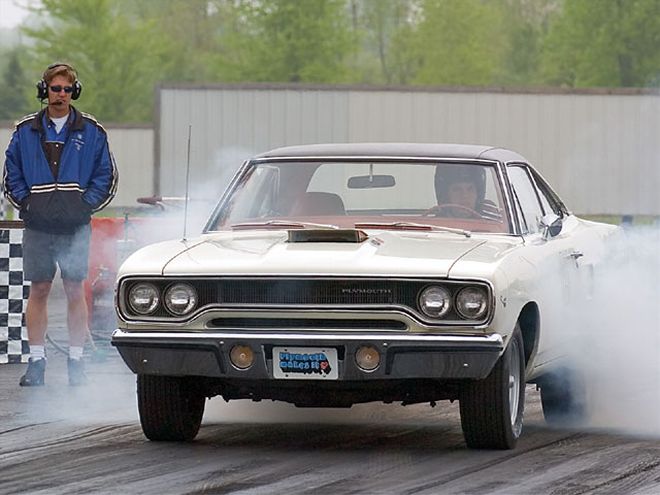

There are many ways for enthusiasts to enjoy their classic Mopar musclecars. Some prefer the all-out performance route, digging deep into aftermarket sources to build an insane animal of a machine. On the other end of the scene, we have the "numbers" crowd, where restoration and authenticity reign supreme. In between, you'll find just about anything else you can imagine.
For David Hakim, marketing manager for DaimlerChrysler's Mopar Performance parts division, the inclination is to look stock and haul butt. Actually, the appeal here is pretty pervasive, with like-minded Mopar warriors duking it out in the popular pure stock, and more liberal and radical F.A.S.T. racing classes. Hakim favors authentic factory muscle, and his preference is un-restored, factory-assembled Survivor cars, the more original the better. His garage contains two examples of just such rarities: an original '71 Hemi Charger R/T, a factory pistol-grip four-speed car, and its stablemate, the infamous Wayne State '70 440 Six Barrel Road Runner, another true original with an authenticated 22,000 miles on the clock.
A pair of such iconic examples of Mopar's muscle would be satisfying enough as garage art, but Hakim doesn't see the point of amassing all that muscle without flexing it once in a while. In fact, there is a certain level of responsibility in ensuring that these cars live up to their legendary status. Hakim relates, "These were some of the fastest cars built in an era known for fast cars, so what's the point in a Hemi or Six Barrel show-car coughing its way down the quarter in the 15s." The point is well taken, as often the focus is taken off performance when looking only at show-field results. Neither of Hakim's cars are show ponies, but they both perform with essentially factory stock mechanicals. Ostentatious non-stock modifications would be an insult to the history and heritage of these rare and original machines.
Of the two cars, the Road Runner sees regular track time, competing in hobby Pure Stock categories or various musclecar shoot-outs, events, and club meets, with last season's best quarter-mile e.t.'s clocking 12.81 at 107.2 mph. The low mileage B-Body has seen a wrench or two over the years, but the combination remains remarkably original. Hakim fills us in, "The shortblock is completely stock and original, the same untouched piece put together by Chrysler in the fall of 1969. We freshened the 906 heads, but did no porting and kept the factory sized 2.08/1.74-inch valves. The factory Six Barrel is original, the manifold, carbs, air cleaner . . . the whole thing. It was just dialed in by Mr. Six Pack, Bob Karakisian. The cam has the factory lift and duration (it idles like stock). It has the original high-performance 440 exhaust manifolds, and, until recently, the rusty factory exhaust. It's pretty much a Six Barrel Road Runner, just tuned and optimized, but completely era correct." Those stout 12.80s are no doubt helped by the Hemi Torqueflite tranny and 4.10-geared Sure Grip-filled 831/44 rear (both factory equipment on this particular car). Keep in mind, the performance numbers quoted are running on factory Goodyear F70-14 Polyglas tires.
Hakim's goal over the winter was to replace the exhaust system, looking to maintain the production system layout and exhaust manifolds, while aiming to improve flow and performance in the bargain. The tti 211/42-inch system fit the bill perfectly. TTI's factory replacement system utilizes more streamlined mandrel bends in place of the original's constricting compression bends, and is designed as a bolt-in system to mate with the factory exhaust manifolds and system hanger locations. For mufflers, the preference is DynoMax's Super-Turbo, a free breathing muffler that retains the original reverse flow system and traditional sound quality. For the installation, the car was taken to the garage of Jack Irons, a leading F.A.S.T. competitor, in Ortonville, Michigan, where Jack Irons Sr. and Jr. handled bolting the pieces in place. As is typical of tti's products, the exhaust went in the chassis without a glitch, bolting in as though they were stock components.
What isn't stock is the flow capacity provided by the better contours of tti's smoothly bent 211/42-inch pipes. The system was terminated with un-adorned down-pipes at the rear bumper, as was original for this car. DynoMax's mufflers provide a pleasing traditional tone, truer to the old-time musclecar sound than today's popular straight-through or chambered performance mufflers. The system looked and sounded good, but the bottom line was whether or not any measurable performance increase could be nabbed at the track.
After the winter thaw, the Road Runner was taken to its home track: Michigan's Milan Raceway. Here, the free-flowing exhaust definitely showed an edge, dropping e.t. substantially to 12.58, while tripping the clocks at 109 mph. Finding a couple of tenths and a couple of mph is an indication of a worthy power increase. The exhaust change helped chip away at the e.t., making this stock-engine Road Runner a solid mid-12-second car, in full street trim. Yes, the good old musclecar days were as good as we remember them.
MOPAR MUSCLE